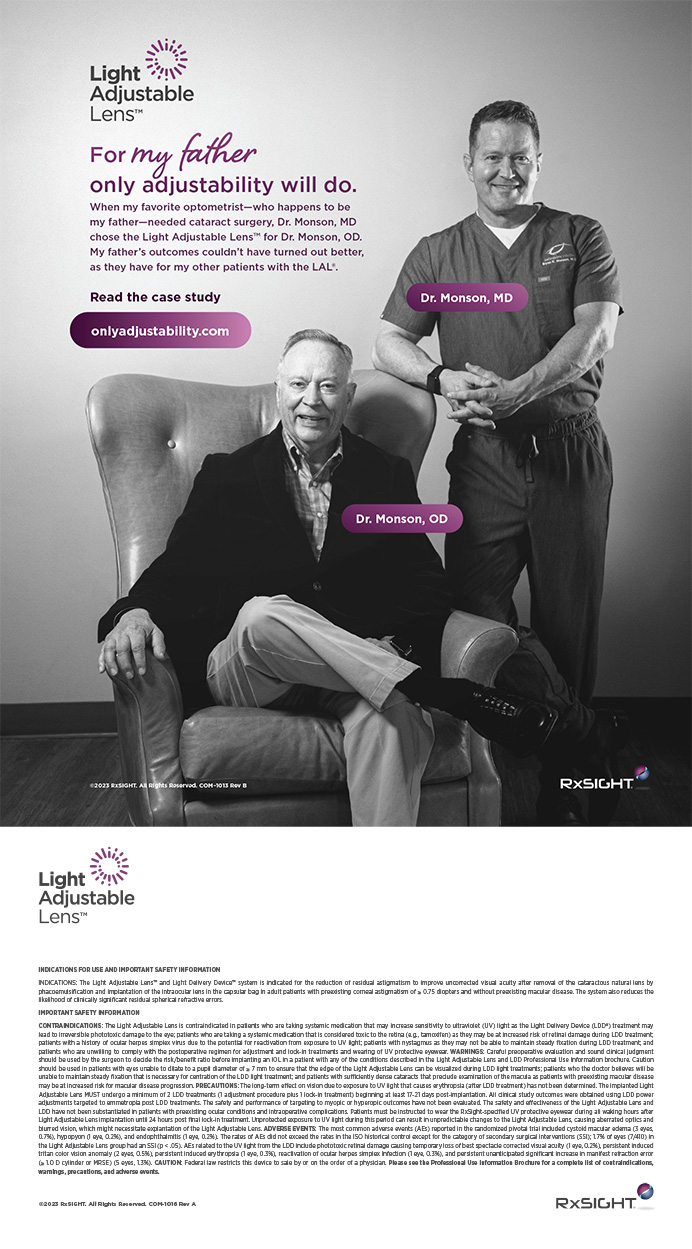A Conservative Approach
Beeran Meghpara, MD

When is a cataract deemed visually significant? The line between offering cataract surgery for a visually significant cataract or lensectomy as a primary refractive procedure can be ambiguous. This distinction carries significant implications for patient counseling, financial considerations, and patient recruitment strategies.
DYSFUNCTIONAL LENS SYNDROME VERSUS CATARACT
Dysfunctional lens syndrome. The term dysfunctional lens syndrome refers to the stage when a normally functioning crystalline lens develops the opalescence of a visually significant cataract. Patients with dysfunctional lens syndrome notice presbyopia and annual shifts in their refractive error. Although their vision might seem slightly diminished compared to before, they are generally content with their vision and encounter minimal disturbances in their daily routines.
Cataract. Objective measurements of a patient’s visual acuity and quality are pivotal when assessing the visual significance of a cataract. Grading cataract density with a slit lamp or a diagnostic device such as the iTrace (Tracey Technologies) can be useful. For me, however, what distinguishes a visually significant cataract is the presence of visual symptoms. Simply put, patients who report a progressive decline in visual function are candidates for cataract surgery. They often initiate the conversation about cataract surgery—possibly because their peers are having similar experiences.
When counseling these patients, I explain that the primary goal of surgery is to replace the clouded lens with a clear IOL. If the patient elects simultaneous correction of their astigmatism and/or presbyopia, the goals and expectations of surgery may change, but the primary objective remains the same.
REFRACTIVE LENSECTOMY
Patient counseling. When patients exhibit early lens changes but retain full visual function, the conversation typically veers away from cataract surgery toward refractive lensectomy. Some express dissatisfaction with their glasses or contact lenses, whereas others might suppress their frustrations.
I do not suggest cataract surgery as the ideal option. Instead, I identify the problem as refractive error and present options to reduce it, treat their presbyopia to extend their range of focus, and abate the routine shift in refractive error that annually requires them to obtain a new glasses prescription.
These patients often have higher expectations than cataract surgery patients and may feel disappointed if they do not achieve spectacle independence after surgery.
Financial considerations. The broader goals of refractive lensectomy coupled with the need for additional diagnostic tests increase the financial burden on the patient. As with any refractive procedure, reimbursement to the physician is not limited by the constraints of insurance company payment.
Patient recruitment. Advances in technology have expanded both the treatment options and pool of candidates for refractive lensectomy. The strategies to attract refractive lensectomy versus cataract surgery patients may differ, even for surgeons who offer laser vision correction.
I categorize refractive lensectomy patients into two general groups.
Group No. 1. These patients are either referred by another eye care provider or self-diagnosed and present seeking a cataract surgery evaluation. The conversation with these patients pivots to an explanation that the cataract is not quite ready for surgery but that the lens can be removed to correct their refractive error, reduce their dependence on glasses, improve their lifestyle, and prevent their need for cataract surgery in the future.
Group No. 2. These patients are considering keratorefractive surgery. The conversation shifts to explaining that factors such as age, refractive error, presbyopia onset, and early lens changes make lens-based refractive surgery a better option.
A Proactive Approach
George O. Waring IV, MD, FACS

More than 1.8 billion individuals worldwide have presbyopia.1 About 96% and 50% of them are likely to be at least somewhat or extremely affected by symptoms, respectively.2 We comprehensive refractive surgeons strive to help our patients through the various stages of ocular maturity throughout their lifetime. Waring Vision Institute takes a proactive approach to refractive lens exchange (RLE), which we describe to patients as custom lens replacement.
In general, we perform corneal laser vision correction or implant phakic IOLs for refractive error earlier in life and IOL replacement procedures for problems that are age-related (ie dysfunctional lens syndrome).3 In addition to refractive error and presbyopia, we have demonstrated that RLE can objectively improve quality of vision for patients with early lens opacity and, in our experience, achieve a higher level of patient satisfaction compared to laser blended vision with LASIK.3,4 RLE helps patients maintain stereopsis and can preserve their depth perception, summed UCVA, and contrast sensitivity. We also educate our patients that RLE is antiaging in that it obviates the need for cataract surgery in the future.
Because the source of the problem—the dysfunctional lens—is addressed, patients tend to do better long term. Specifically, hyperopic corneal laser vision correction to induce blended vision can be useful in certain patients. With the eventual progression of presbyopia, potential for regression for hyperopic LASIK, and potential limitation for presbyopia-correcting IOL selection over hyperprolate corneas, however, RLE is our preferred choice for the treatment of dysfunctional lens syndrome.
We objectively demonstrate lens dysfunction in its various stages by taking patients on a virtual diagnostic tour of their eyes. Patients are educated on the potential shortcomings of RLE, including dysphotopsia, a need for reading glasses, opacification of the IOL or capsular bag that may require polishing, and residual refractive error that may require an enhancement or IOL exchange as well as the risks of the procedure.
RLE patients are some of the most satisfied in our practice. One component of their decision-making process, however, must be understanding the financial implications of the procedure. Because it is not covered by insurance, a patient is responsible for the full cost. Part of this conversation with patients is highlighting the long-term financial benefits of RLE: It reduces or eliminates the need for glasses and contact lenses. We also position the procedure as adding to their quality of life.
CONCLUSION
Our practice takes a proactive approach to refractive lensectomy. We’ve evolved our focus to include presbyopia correction as a core component of the procedures we offer. This has become one of the fastest-growing segments in our practice, and I am excited to watch it grow more. Ultimately, we believe this approach to patient care prioritizes individual needs and goals to ensure patients receive the most appropriate treatment.
1. Alió JL, Schimchak P, Negri HP, Montés-Micó R. Crystalline lens optical dysfunction through aging. Ophthalmology. 2005;112(11):2022-2029.
2. Waring IV GO. Diagnosis and treatment of dysfunctional lens syndrome. Cataract & Refractive Surgery Today. 2013;13(3):36-38.
3. Waring GO IV, Rocha KM. Characterization of the dysfunctional lens syndrome and a review of the literature. Curr Ophthalmol Rep. 2018;6:249-255.
4. Tremblay DM, Waring IV GO, Din HA. Evaluation of improving in forward light scatter and ocular scatter index with double-pass wavefront after dysfunctional lens replacement. Paper presented at: ASCRS/AOA Annual Meeting; April 21, 2015; San Diego.




